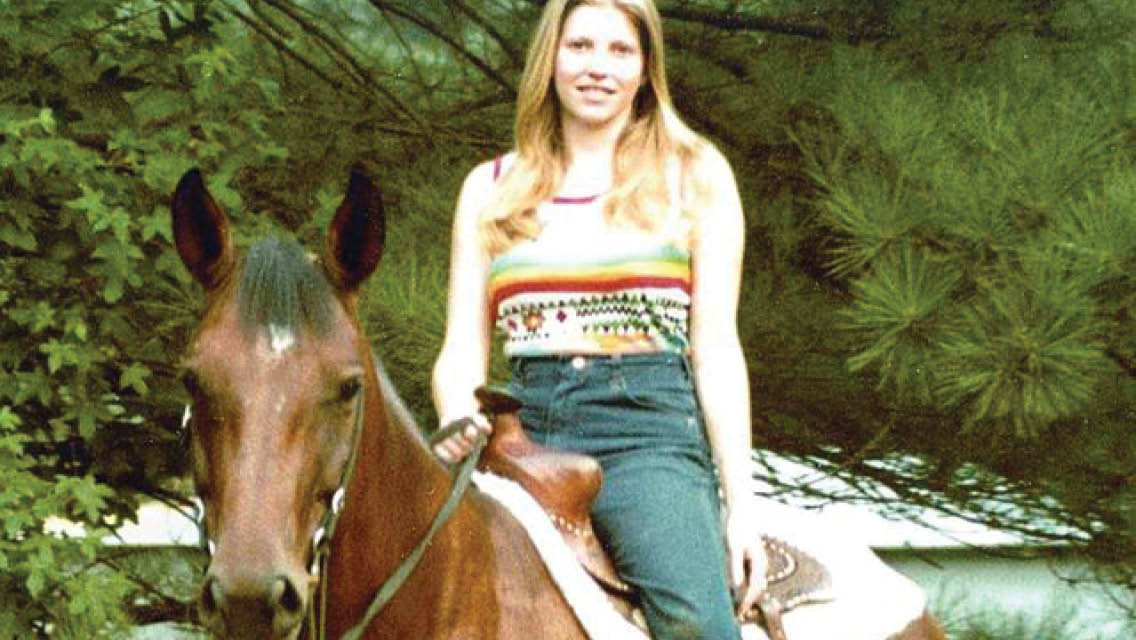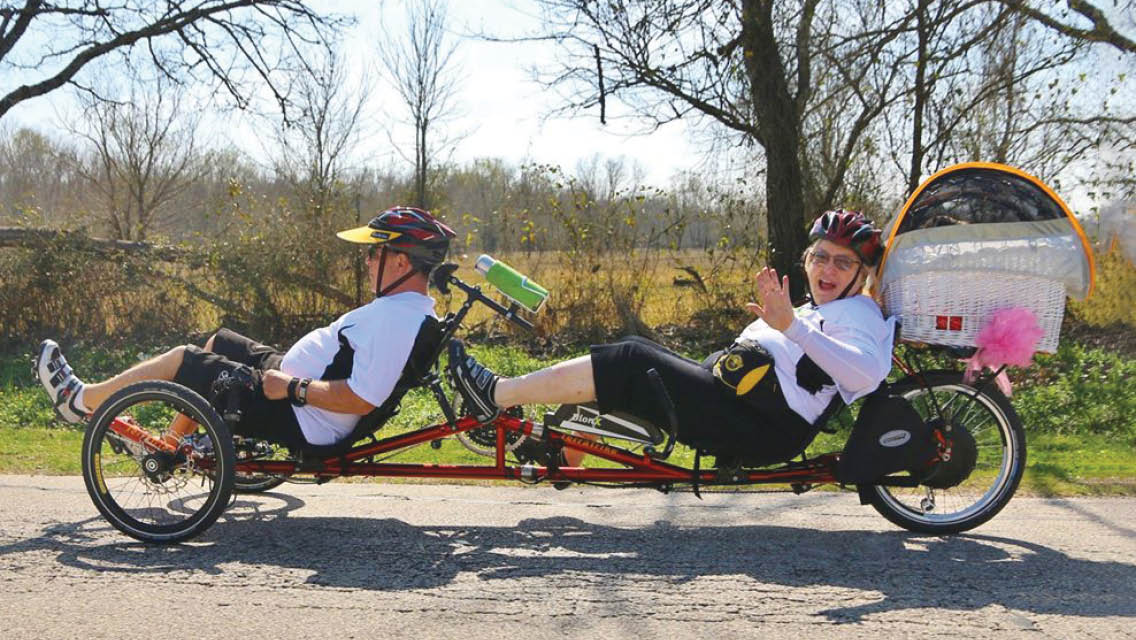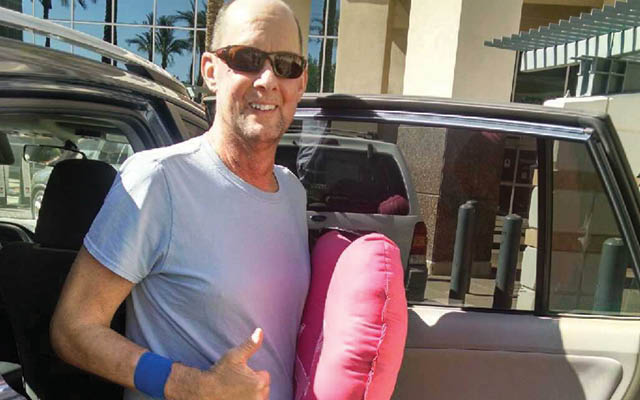Some days unfold exactly right: On the afternoon of the recumbent-cycling 5K time trials at the 2019 Arkansas Senior Games, I greeted all my “bent” friends (short for “recumbent,” the type of bicycles and tricycles we pedal, in a reclining position) at the check-in area.
At start time, I shot onto the course with a broad grin on my face. Confident and pedaling strong, I was never winded. When I zoomed across the finish line 11 minutes later, my husband, Greg Long, and my service pug, Sweet P, were cheering me on.
Though I won the gold medal in my age category, that was just icing on the cake. The real victory was feeling active and healthy after having been physically dormant for half my lifetime.
In 1982, at the age of 21, I was injured in a horseback-riding accident. Every bone in my skull except my nose was broken when I slammed into a low tree branch while trying to control my bolting horse.
I was in a coma for the following 16 days, and the neurosurgeon told Greg that I had a less than 5 percent chance of surviving. I spent three months in the hospital, and the head injury left me deaf, legally blind, and with permanent balance issues. Extensive damage to my facial nerves required another surgery.
To this day, the left side of my mouth remains paralyzed, and my half-smile is unconventional. Even so, there’s a lot to smile about, including my family’s never-flagging support.

Making Progress
My muscles atrophied during those months in the hospital, and relearning how to walk was excruciatingly slow. I was as weak as a newborn and had to start from scratch on everything.
Before the accident, I had bicycled and played tennis and was an experienced horsewoman. I had also earned a bachelor of fine arts degree in photography. Suddenly I had to find new ways to walk, communicate, and see with what vision I had (20/400 without glasses).
My mother moved into our Houston-area home for two years to help. She would drive me to a swimming pool and hold me while I practiced walking in water. Little by little, I was able to get around with a walker. Later, I could shop; pushing a grocery cart stabilized me.
After I became deaf, I relied on lip reading to understand others. However, after an experience struggling to understand my young son, John (the doctor had told me I wouldn’t be able to get pregnant because of my injuries, but John was a miracle baby born in 1984), I craved a more efficient way to communicate with him. Luckily, I discovered cued speech, a system of eight hand shapes made in four positions around the face while speaking to help visually differentiate between speech sounds.
Four years after the accident, I joined a gym to rebuild my strength. However, when I got a cochlear implant in 1989, the surgeon ordered me to stop lifting — even a bag of flour was too heavy — because my cochlea was just 1 millimeter from being punctured, a result of the injuries I’d sustained. I needed to quit the gym, but the implant was successful, and I was able to hear my 5-year-old son’s voice for the first time.
In the 40 years since my life changed so dramatically, I’ve never been depressed. Instead of focusing on activities I’d never do again, I concentrated on things I could do. For example, I was grateful to be able to push John in a stroller. And despite the blindness in one eye, I became an avid quilter and cross-stitcher.
In 1995, I earned a master’s degree in deaf studies. As the adult-cued-speech representative for the National Cued Speech Association, I made presentations nationwide.
Rediscovering My Athleticism
I also never gave up the dream of being active again, and I hung on to hope that something would change. And in 2007, it did — at just the right time.
In my late 40s, I was noticing changes in my body: ballooning weight, high blood pressure, and a sluggish feeling I couldn’t shake. While browsing the internet, I spotted a photo of a recumbent trike. I can do that! I thought. Because it had three wheels, there was no danger it would fall over, so my lack of balance wouldn’t be a problem.
A recumbent is safer and more ergonomically friendly than a bicycle: You get an incredible aerobic and muscular workout without the sore rear end, back, and arms. You can ride farther and longer than on a normal bike — without the forward hunch and neck strain. On a recumbent, you enjoy a normal view.
I found a shop that sold recumbent cycles and tested one. From the first pedal stroke, I felt like someone had unlocked the cell door and set me free. After 25 years, I had true physical independence — and for a second time, my life changed in a flash.
I embraced the physical challenge of going from almost no activity to pedaling. I loved setting and achieving small goals: riding a little faster, a little farther.
As my legs got stronger, I could also walk more confidently. Gradually, my health improved, and I felt more vibrant.
My social life bloomed. I began meeting other recumbent cyclists and suggesting we ride together. Soon I was organizing rides for a group in the Dallas–Fort Worth area.
Later, I created Facebook groups for Texas Recumbent Riders and Recumbent Ladies so that recumbent cyclists around the state, country, and world could share their experiences and knowledge about riding. We also compare our favorite riding songs.
After being isolated for so long, I now have friends all over the world.
Cycling Back to Health
Even though I love recumbent cycling, during my late 50s I tended to slack off if it was hot or I was busy. When concerning symptoms popped up again, I realized I had to gear up.
In 2017, the Dallas Senior Games began including recumbent-cycle competitions: a perfect motivator for stepping up my physical training.
On race day, I wasn’t in the best shape to handle the grueling uphill course in a strong headwind, but I persevered and won both the 5K and 10K time trials. The biggest prize that day was that I had recommitted to my physical health.
With other races on the horizon, I focused on a healthier diet. That, along with riding 10 miles daily on a stationary turbo trainer with a trike on it, helped me drop more than 50 pounds in a year. Now my vital signs are excellent, and at 64, I feel like I’m going on 34!
In May, I’m heading to the National Senior Games in Florida to compete in the 5K and 10K time trials in recumbent cycling. Winning doesn’t matter, though: Whether I’m going all out during an adrenaline-fueled race or leisurely pedaling a tandem with my husband on a scenic trail, recumbent riding is my happy place.
Jane’s Top 3 Success Strategies
- Avoid comparing yourself with other riders. “It took me years to quit setting goals that were unrealistic or something I didn’t care about,” says Jane. “Stick to your personal goals. What works for others might not work for you.”
- Measure your success by how you feel. With impaired eyesight, Jane can’t read a bike computer. “I never know how fast or far I go, how many pedal strokes I make or calories I burn,” she says. “If I’m spooked about going too fast, I am going too fast. Also, I never want to ride so far I wish I were not riding.”
- Keep it fun — and keep doing it! Getting in shape doesn’t have to be boring. Jane’s upbeat soundtrack for riding her indoor recumbent trike includes “December, 1963 (Oh, What a Night)” by Frankie Valli and the Four Seasons, Elton John’s “Philadelphia Freedom,” and Olivia Newton-John’s “Physical.”
Tell Us Your Story! Have a transformational healthy-living tale of your own? Share it with us!
This article originally appeared as “Wheels Keep On Turning” in the April 2022 issue of Experience Life.





This Post Has 0 Comments